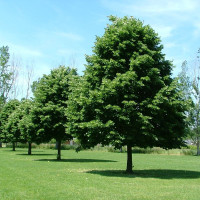Midland hawthorn or English hawthorn, woodland hawthorn,or mayflower / Crataegus laevigata - is a shrub or small tree of the Rosaceae family up to 5 meters high. Shoots are purple-brown, shiny, covered with hard spines. Leaves alternate, petiolate, obovate or broadly rhomboid, pointed; lobes serrated, short-pubescent on both sides. Blooms in May - June. The flowers are small, white, in dense thyroid inflorescences, with a slight specific smell. The fruit is blood red, rarely brownish, sweet and sour, with mealy pulp. Ripens at the end of August.
Hawthorn is a hardy plant. It does not require special methods of cultivation. Cultivated in parks and squares far beyond the natural range. Propagated by seeds and shoots. Forms hedges.
Used in the national economy. Solid hawthorn wood is used to make turning products. The bark is used to dye fabrics red. Jam, jelly, coffee substitute and tea are prepared from fruits. Flour from dried berries is added to the dough to make bread with a fruity flavor.
Medicinal raw materials are flowers, fruits and leaves. Hawthorn blooms very quickly, in 3-4 days. Flowers are harvested at the beginning of flowering, until they are all opened.
Preparations from hawthorn are used for heart diseases, especially for fatigue of the heart muscle. They selectively dilate the coronary and cerebral vessels, reduce the excitability of the nervous system, increase the supply of oxygen to the heart and brain, improve metabolism, normalize the heart rhythm, eliminate discomfort in the heart area, normalize sleep and general condition, help speed up recovery after serious illnesses and lowering blood cholesterol levels. With prolonged use, there is a decrease in blood pressure in the initial stages of hypertension.
The positive effect of hawthorn was noted for dizziness, shortness of breath, insomnia, and also when used in menopause.

No questions about this product, be the first and ask your question.


















